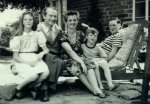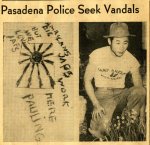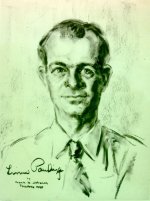
The War Years, Part 2 (1943-1945)
1943
Pauling makes increasing use of animals, especially rabbits, guinea pigs, and mice, in his immunochemical work. Therefore, in February, he requests funds for an animal house to be constructed on the roof of Gates Chemical Laboratory (Pauling has been using the animal rooms of the biology division).
Pauling, Pressman, and Campbell continue to publish papers in their series on the serological properties of simple substances.
In June, the Rockefeller Foundation announces that it will continue to support Pauling’s immunological work at CIT, noting that it has attracted a large number of graduate students.
On October 19, Nora Gard Miller dies in Portland, Oregon.
1944
With several collaborators, Pauling and Pressman publish the sixth, seventh, and eighth papers in the series on the serological properties of simple substances.
Pauling delivers the Julius Steiglitz Memorial Lecture on January 27 for the Chicago Section of the American Chemical Society. The title of his talk is "Chemical Experiments on the Structure of Antibodies and the Nature of Serological Reactions."
Oswald T. Avery, Colin M. MacLeod, and Maclyn McCarty discover that deoxyribonucleic acid transforms one strain of bacteria into another, but Pauling, Mirsky, and other chemists and biochemists are initially skeptical, maintaining that proteins are the most likely carriers of genetic information.
In June, the Rockefeller Foundation announces another grant to CIT to support Pauling’s research on the chemical basis of the immune reaction and A.H. Sturtevant’s study of problems in serological genetics.
Pauling and Corey begin making plans for a vigorous attack on the problem of the structure of proteins in the postwar period. Pauling hopes to make use of a large number of well-trained scientists who will be looking for employment at the war’s end (Pauling and Corey have over fifty young men and women working on their NDRC projects).
1945
Pauling and Pressman with various collaborators publish the ninth, tenth, and eleventh papers in the series, "The Serological Properties of Simple Substances."
In February, Pauling and Campbell announce that, as a result of three years of work, they and their collaborators have developed a successful substitute for blood plasma from gelatin (this substitute, called oxypolygelatin, was made under an OSRD contract).
During the night of March 5 to 6, insults and a Nipponese flag are painted in red on the garage door of the Paulings’ home at 3500 Fairpoint Street. Pauling had employed a Japanese-American, George H. Nimaki, a returned Nisei evacuee, as a gardener. One of the insults states "Americans die but we love Japs." Pauling speaks out strongly against this "un-American act."
On April 12, President Franklin D. Roosevelt dies in Warm Springs, Georgia. Ava Helen in Pasadena and Linus on a train from Washington to the Allegheny Ballistic Laboratories receive the news with shock and sadness, since they were both active supporters of the president and his causes.
In the spring, Pauling serves, together with eight other men from various American medical schools, as a member of the Medical Advisory Committee whose job is to help in the preparation of the Bush Report (about science in America after the war). Dr. William B. Castle, Professor of Medicine in Harvard University, tells committee members about the disease sickle-cell anemia. Pauling quickly gets the idea that the hemoglobin molecules in the red cells must be involved in the phenomenon of sickling and that the differences between the sickled red corpuscles and normal red corpuscles might be explained by abnormal hemoglobin in the sickled cells.
On April 18, at a meeting of the Research Board for National Security (with several generals and admirals in attendance), Pauling argues that it is in the province of this board’s responsibilities to do research on how to avoid war.
Pauling is cited by Dr. Vannevar Bush, OSRD director, for his contributions to the war effort, in particular for the experiments that he did on rockets for the Navy.
Pauling becomes a member of CIT’s Executive Committee (he serves for three years).
Roscoe G. Dickinson dies on July 13. Pauling speaks at a memorial service for Dickinson in the Gates and Crellin Laboratories.
In August, Pauling becomes concerned when he reads in the newspapers about the atomic bombs that have been dropped on Hiroshima and Nagasaki. He begins giving talks about atomic bombs for local groups, initially restricting his remarks to the science and technology involved in the weapon.
Pauling becomes a member of the board of directors of the Hollywood Independent Citizens Committee of the Arts, Sciences, and Professions (he serves as vice chairman from 1945).
Some of Pauling’s lectures on the atomic bomb create controversy. For example, at a talk before the Hollywood Independent Citizens Committee in December, he makes the guess that there are perhaps a hundred or even two hundred atomic bombs in existence (we know today that Pauling greatly overestimated the bombs then in existence, and his estimate created skepticism even then). On another occasion, Pauling mentions in his lecture the amounts of uranium and plutonium needed for nuclear weapons, for he is appalled by how cheaply and easily they can be made. After the lecture, an agent from the Federal Bureau of Investigation (FBI) visits him, asking him where he has obtained his data. Pauling tells him that he has calculated the amounts from the available information in scientific papers.
After a lecture before the Rotary Club of Hollywood in which he explains the nature of atomic bombs, he gives a similar talk before another group in which he discusses not only the nature of nuclear fission but also the transformation in the nature of war caused by this new weapon. After the lecture, his wife tells him that he was effective in talking about the scientific aspects of the bomb, but she says, "when you talk about the nature of war and the need for peace, you are not convincing, because you give the audience the impression that you are not sure about what you are saying." Pauling has said that his wife’s statements on this occasion changed his life. He decides to devote a large portion of his time learning about international relations, international law, treaties, histories, the peace movement, and other subjects relating to the whole question of how to abolish war from the world and to achieve peace. (During the following years, Pauling will give hundreds of lectures about nuclear weapons and the need for world peace.)
Table of Contents
- The Ancestry of Linus Pauling (The Paulings)
- The Ancestry of Linus Pauling (The Darlings)
- Linus Pauling's Childhood (1901-1910)
- Linus Pauling's Adolescence (1910-1917)
- Pauling's Years as an Undergraduate at Oregon Agricultural College, Part 1 (1917-1919)
- Pauling's Years as an Undergraduate at Oregon Agricultural College, Part 2 (1919-1922)
- Linus Pauling as a Graduate and Postdoctoral Student at the California Institute of Technology, Part 1 (1922-1923)
- Linus Pauling as a Graduate and Postdoctoral Student at the California Institute of Technology, Part 2 (1924-1926)
- A Guggenheim Fellow in Europe during the Golden Years of Physics (1926-1927)
- Early Career at the California Institute of Technology (1927-1930)
- Pauling's Great Years of Achievement in Structural Chemistry, Part 1 (1931-1932)
- Pauling's Great Years of Achievement in Structural Chemistry, Part 2 (1933-1935)
- Pauling's Increasing Involvement in Molecular Biology (1936-1939)
- The War Years, Part 1 (1940-1942)
- The War Years, Part 2 (1943-1945)
- The Postwar Years, Part 1 (1946-1947)
- The Postwar Years, Part 2 (1948-1949)
- Proteins, Passports, and the Prize (1950-1954)
- Increasing Involvement in World Peace, Part 1 (1955-1958)
- Increasing Involvement in World Peace, Part 2 (1959-1963)
- The Center for the Study of Democratic Institutions (1964-1967)
- The University of California, San Diego (1968-1969)
- Stanford University (1969-1972)
- An Institute for Science and Orthomolecular Medicine, Part 1 (1973-1977)
- An Institute for Science and Orthomolecular Medicine, Part 2 (1978-1981)
- The Years Alone: Pauling after the Death of Ava Helen, Part 1 (1982-1988)
- The Years Alone: Pauling after the Death of Ava Helen, Part 2 (1989-1994)
- About the Author




